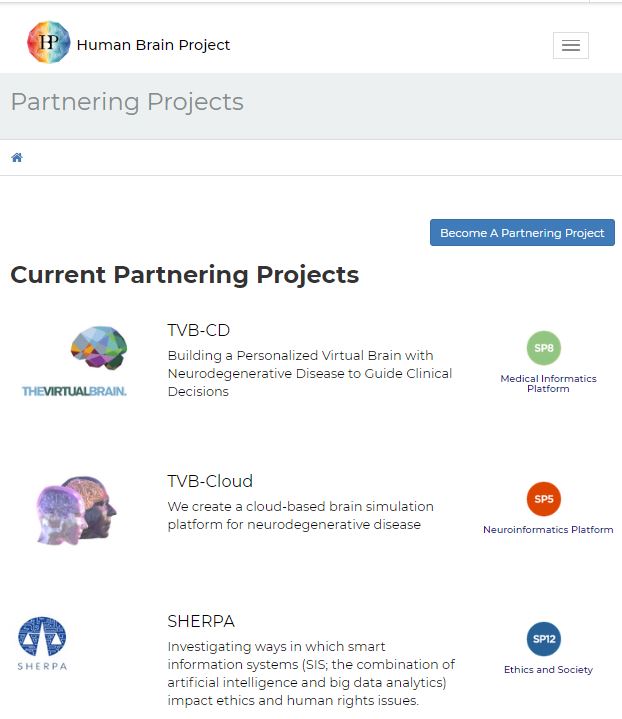FLAG-ERA finances 25 FET Flagship projects. Nine new Partnering Projects Join The Human Brain Project
13 November 2019
FLAG-ERA, the Flagship ERA-NET, will fund 25 transnational projects in synergy with the Graphene Flagship and the Human Brain Project as a result of its fourth Joint Transnational Call (FLAG-ERA JTC 2019).

FIND OUT MORE ABOUT HBP PARTNERING PROJECTS ON THE @HBPProjects HOMEPAGE
FLAG-ERA is pleased to announce the results of its fourth Joint Transnational Call (FLAG-ERA JTC 2019). 25 transnational projects were selected for funding after evaluation by an independent international scientific evaluation panel supported by external reviewers. The selected research projects include 16 projects in synergy with the Graphene Flagship and 9 with the Human Brain Project (HBP), for a total budget of € 16.4 million. The general success rate of the call and the success rate in each subcall is 30%.
Among the 16 projects related to the Graphene Flagship, 9 are in the Basic Research subcall and 7 in the Applied Research and Innovation subtopic. In the Basic Research subcall, projects are focused on sensors from Graphene and related materials (GRMs) and their heterostructures, synthesis and characterization of layered materials beyond graphene, GRMs for Quantum Technologies, spin torque and layered-materials-based memory building block and synthesis of monolayers of non-layered compounds. In the Applied Research and Innovation subcall, projects will be dedicated to sensors from GRMs and their heterostructures, synthesis and characterization of layered materials beyond graphene, nanofluidics based on GRMs, LIDAR based on GRMs for autonomous vehicles, GRM-based tandem solar modules and soft graphene-based materials for tissue engineering.
Concerning the 9 projects related to HBP, focus will be placed on reconstruction of neuronal morphology from microscopic image data, the development and maturation of cognitive processes and multisensory integration at micro- and macro-scales, testing neuronal models at multiple scales, testing neuronal models at multiple scales, disease modeling and simulation, subcortical structures – from cognition to action and the neuroscience of decision-making.
Consult the full list of FLAG-ERA JTC2019 funded projects and partners.
The new Human Brain Project Partnering Projects which have received funding are listed below:
List of projects for the sub-call “HBP – Basic & Applied Research and Innovation” (alphabetical order)
| Acronym and title | Coordinator | |
| DOMINO – Development of cortical multisensory integration mechanisms at micro- and macro- scales during normal and pathophysiological conditions | Umberto Olcese University of Amsterdam |
NL, FR, GR, IT |
| HA-CTion – Hypothalamic histaminergic modulation of brain regions involved in fear memory | Beatrice Passani University of Florence |
IT, FR, NL |
| MILEDI – Multiscale Modelling of Impaired LEarning in Alzheimer’s Disease and Innovative Treatments | Ausra Saudargiene Lithuanian University of Health Sciences |
LT, FR, IT |
| MoDeM – The “Motor-way” to Decision-Making: how the motor system drives cue-triggered decisions | Giuseppe de Pellegrino University of Bologna |
IT, FR, NL |
| NeuronsReunited – Neurons reunited: data and software to reconstruct long-range projection neurons, place them in a digital reference brain with high precision, and model their interactions | Paul Tiesinga Radboud University |
NL, DE, BE, ES, IT |
| PrimCorNet – Layer-specific characterization and modeling of fronto-parietal dynamics in primate cortical networks | Thomas Brochier Institut de Neurosciences de la Timone |
FR, DE, GR |
| SENSEI – Segmentation of Neurons using Standard and Super-Resolution Microscopy | Nicola Vanello Research Center “E. Piaggio” – University of Pisa |
IT, BE, FR |
| SMART BRAIN – Advanced Morphological Reconstruction of Human Brain Tissue by Multimodal Fusion of Multiscale Optical Imaging Technologies | Jonathan Mapelli Università degli Studi di Modena e Reggio Emilia |
IT, FR, NL |
| SoundSight – The sight of sound: how vision shapes the development of auditory inputs to the occipital cortex | Christian N Levelt Netherlands Institute for Neuroscience / KNAW |
NL, BE, ES |
*bold = coordinating country, italics = without JTC funding



